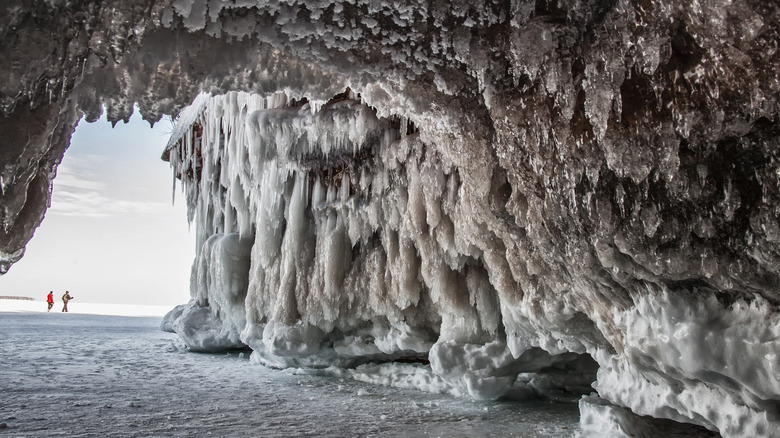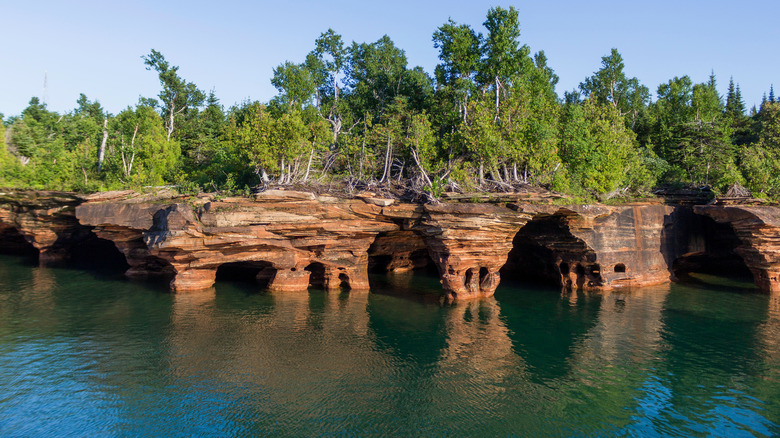Lake Superior, the largest of the Great Lakes, might seem like the perfect place to go fishing or hop on a boat come summer. But the freshwater destination also makes for an exciting winter wonderland — when the conditions are right, that is. The Apostle Islands National Lakeshore, an area of coastline in Bayfield, Wisconsin, becomes the site of stunning ice caves when the mercury drops and the water freezes over. However, the caves are only accessible when experts deem them safe and sturdy enough to visit.
According to the National Park Service, the last time the caves were open to the public was during a short period in 2015. Before that, the natural marvel was accessible in 2014 and nearly every winter between 2003 and 2009. If current patterns continue, the ice formations will become increasingly rare with each year.
The reason for the closures relates to how and where the caves form. Unlike the caves you might find tucked within a mountain or buried deep in the ground, the Apostle Islands National Lakeshore caves form on the lake’s surface. Accessing them involves a trek across a frozen bridge, which can break or melt without notice. As if that wasn’t risky enough, the Bayfield Chamber & Visitor Bureau notes that visitors who get hurt during their visit must wait up to four hours to receive emergency care, given how difficult it is to reach the caves. Put simply, conditions must align perfectly before officials agree to give the green light.
Will the caves reopen?

It’s hard to predict if and when the ice caves at Lake Superior will be safe to access, but the period with the highest chance is between mid-February and mid-March. The National Park Service will only give the go-ahead if weather conditions are stable, a frozen path has formed between the points needed for hiking, and the ice is thick (between 10 and 12 inches) and hasn’t suffered any breaks within the past week.
One of the easiest ways to stay informed on the current status of the ice caves is by calling the designated “ice line” at 715-779-3398, followed by extension number 3. Apostle Islands National Lakeshore may also update its Facebook page with updates as they become available.
If you’re fortunate enough to visit the surreal caves once they reopen, expect to pay $5 per person over the age of 16 to enter. Locate the parking area at Meyers Beach Road (arrive early to ensure there’s space — otherwise you might be forced to park miles away from the entrance) and head to the stairs. From there, prepare to walk at least one mile before reaching the ice formations. You should dress appropriately for the cold weather, including wearing proper shoes for the trek. Leave your favorite sneakers at home and grab some spiked footwear instead.
What to do if the ice caves are closed

The Lake Superior ice caves are an incredible sight, but they’re not the only way to enjoy the coastal area of Wisconsin. When the caves aren’t accessible, layer up your outerwear, put on your winter-weather hiking boots, and explore the mainland trail located just above the caves. You might still be treated to an amazing view of the formations, even if you can’t see them up close.
Another option is to check out the other caves in the area. Red Cliff Bay, located a 20-minute drive from the Apostle Islands National Lakeshore caves, is home to some icy structures of its own. They may not be as famous, but they’re still worth a visit to see the wintery sculptures blanket the cove’s rust-colored cliffs.
Finally, don’t forget that while the caves might be closed up during the winter, they show their true colors (literally) once the ice thaws. Visit during the warmer months to witness the awe-inspiring beauty of the red and orange sea caves via kayak or boat. When the water is calm enough, you can even venture inside the arches for an intimate look at the spectacular nature-made architecture.

